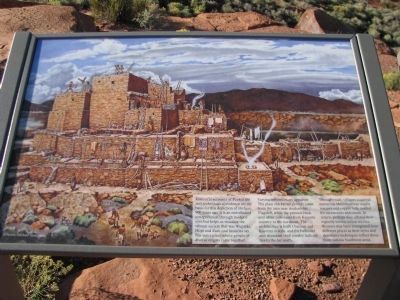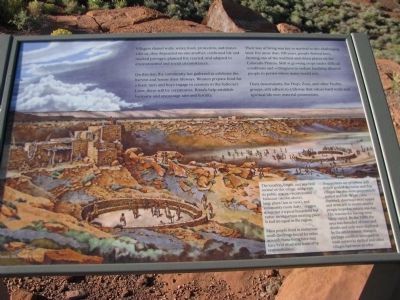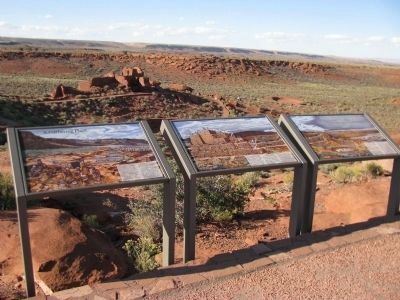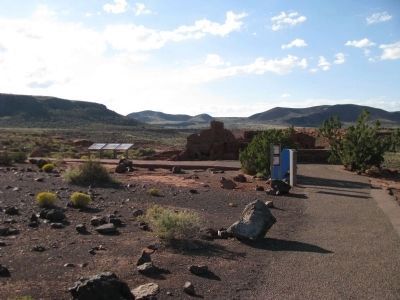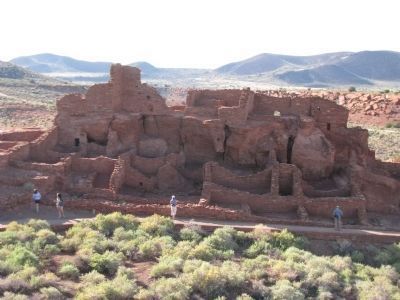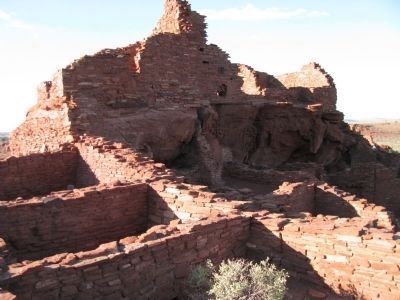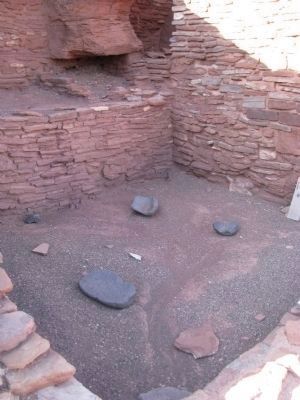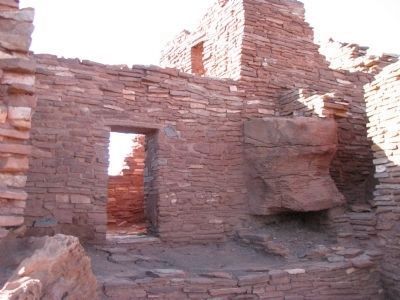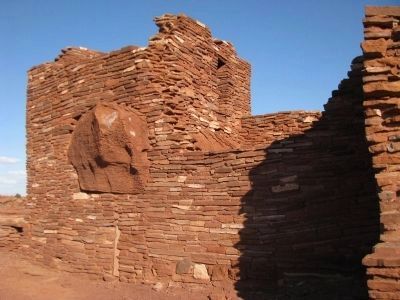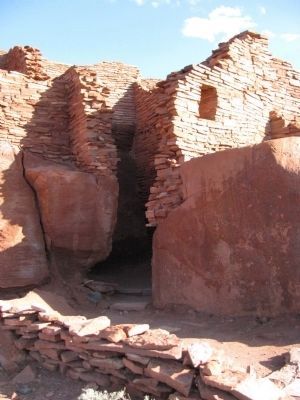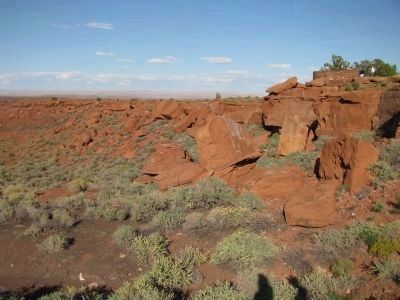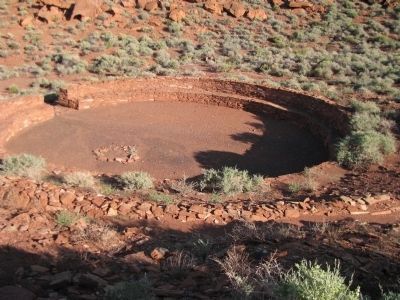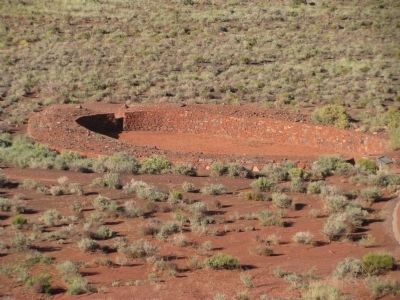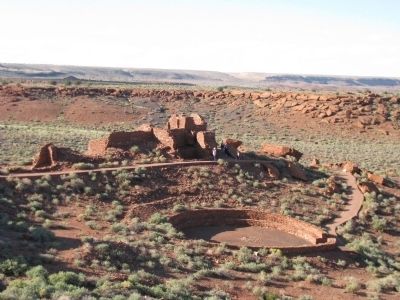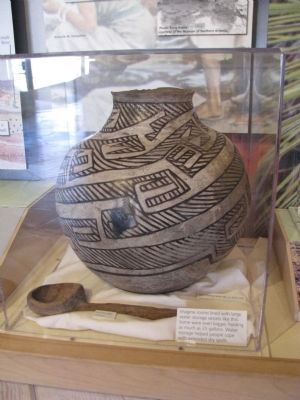Flagstaff in Coconino County, Arizona — The American Mountains (Southwest)
A Gathering Place
]Panel 1:]
Between 1100 and 1200, more people lived in this area than ever before, or since. Located along routes linking large populations to the northeast and south, villages here were well situated for trade. As people, goods, and ideas converged on the area, a complex society of several thousand evolved. This particular village became the heart of a thriving community and was a landmark, a gathering place, and a ceremonial center.
It is remarkable that this land, so dry and hot, supported a large farming community. Moisture conserving cinders from the eruption of nearby Sunset Crater Volcano made for slightly better farming conditions during the 1100s. But extensive land and labor would have been required. This monumental structure may have signaled control over farm lands and united a community that undoubtedly changed as it grew and accepted immigrants.
[Panel 2:]
Historical accounts of Pueblo life and archeological evidence are the basis for this depiction of life here 900 years ago. It is an embellished interpretation through modern eyes but helps us visualize the vibrant society that was Wupatki. Hopi and Zuni oral histories say this was a place where people of diverse origins came together.
Varying influences are apparent. The plain red-brown pottery came from the area near modern day Flagstaff, while the painted black and white pots came from Kayenta country to the northeast. The architecture is both Chacoan and Kayenta in style, and the ballcourt and abundant shell jewelry indicate ties to the far south.
Through trade, villagers acquired numerous Mesoamerican scarlet macaws and copper bells needed for ceremonies and rituals. In return, perhaps they offered their expertly woven cotton textiles. Weavers may have immigrated from different places as their styles and decorative techniques reflect those from various Southwest areas
[Panel 3:]
Villagers shared walls, water, food, protection, and prayer. Like us, they depended on one another, celebrated life and marked passages, planned for, reacted, and adapted to environmental and social circumstances.
On this day, the community has gathered to celebrate the harvest and honor their lifeways. Women prepare food for a feast; men and boys engage in contest in the ballcourt. Later, there will be ceremonies. Rituals help establish harmony and encourage rain and fertility.
Their way of living was key to survival in this challenging land. For more than 100 years, people thrived here, farming one of the warmest and driest places on the Colorado Plateau. Skill at growing crops under difficult conditions and willingness to endure hardship allowed people to persist where many would not.
Their descendants, the Hopi, Zuni, and other Pueblo groups, still adhere to a lifeway that values hard work and spiritual life over material possessions.
The location, height, and size (100 rooms) of this village, along with its public spaces — a ceremonial ballcourt (shown above), large plaza (not in view), and community room (left) — suggest it was not a typical househould but rather an important meeting place. It had no equal in the region.
Most people lived in numerous small dwellings found for miles around; those living here may have held ritual and leadership responsibilities.
Descendants say prophecy and beliefs guided decisions and that villages like this were purposefully settled and left. When clans departed, doorways were scaled and items left in rooms; maybe people hoped to return one day. The reasons for leaving were likely varied. By the 1200s the area was denuded of trees and shrubs and soils were depleted. As the environment changed, perhaps conflicts increased or trade networks shifted and other villages had more to offer.
Erected by National Park Service.
Topics. This historical marker is listed in these topic lists: Anthropology & Archaeology • Native Americans.
Location. 35° 31.261′ N, 111° 22.366′ W. Marker is in Flagstaff, Arizona, in Coconino County. Marker is on Loop Road, on the left when traveling north. From Flagstaff, take US 89 north for 12 miles (19km), turn right at sign for Sunset Crater Volcano - Wupatki National Monuments. The Visitor Center is 21 miles (34km) from this junction. Touch for map. Marker is at or near this postal address: Loop Road, Flagstaff AZ 86001, United States of America. Touch for directions.
Other nearby markers. At least 8 other markers are within 7 miles of this marker, measured as the crow flies. The Ballcourt (about 700 feet away, measured in a direct line); The Blowhole (about 700 feet away); Wukoki (approx. 2˝ miles away); Nalakihu (approx. 6.4 miles away); Where Were The Fields? (approx. 6.4 miles away); The Citadel / Natural Features (approx. 6.4 miles away); A Village/Abandonment (approx. 6.4 miles away); Community (approx. 6.4 miles away). Touch for a list and map of all markers in Flagstaff.
Credits. This page was last revised on June 16, 2016. It was originally submitted on October 7, 2012, by Denise Boose of Tehachapi, California. This page has been viewed 716 times since then and 16 times this year. Photos: 1, 2, 3, 4, 5, 6, 7, 8, 9, 10, 11, 12, 13, 14, 15, 16, 17, 18, 19. submitted on October 7, 2012, by Denise Boose of Tehachapi, California. • Syd Whittle was the editor who published this page.

